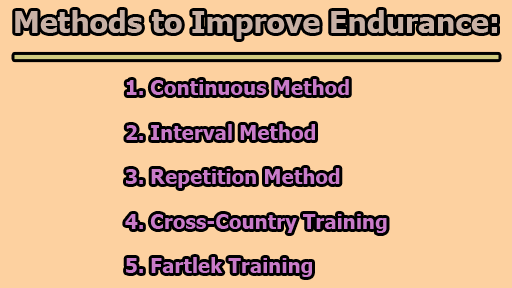Methods to Improve Endurance:
Improving endurance is crucial for athletes and fitness enthusiasts across various sports and activities. Endurance can be defined as the ability to sustain prolonged physical effort over an extended period of time. It is an essential component of overall fitness and performance, whether you’re a long-distance runner, a cyclist, a swimmer, or simply someone looking to enhance your cardiovascular health. There are several methods and training techniques that can help individuals enhance their endurance levels. In this article, we will delve into five primary methods to improve endurance: the Continuous Method, Interval Method, Repetition Method, Cross-Country Training, and Fartlek Training.
1. Continuous Method: The Continuous Method is a foundational approach to improving endurance. It involves performing a steady, sustained activity at a moderate intensity for an extended period of time. This method primarily targets the aerobic energy system, which is responsible for providing energy during prolonged, low-to-moderate intensity activities.
How to Implement the Continuous Method:
- Choose Your Activity: The Continuous Method can be applied to various aerobic exercises, including running, cycling, swimming, rowing, or even brisk walking. Select an activity that you enjoy and can perform consistently.
- Set Your Duration: Start with a duration that matches your current fitness level. Beginners might begin with 20-30 minutes, while more advanced individuals can aim for 60 minutes or more.
- Maintain a Steady Pace: During the activity, aim to maintain a consistent and manageable pace. You should be able to hold a conversation without feeling overly breathless.
- Monitor Intensity: You can use a heart rate monitor or the Rate of Perceived Exertion (RPE) scale to gauge your intensity. Aim for a moderate intensity, typically around 60-70% of your maximum heart rate or a perceived effort level of 5-6 on a scale of 1-10.
- Gradual Progression: Over time, gradually increase the duration or intensity of your continuous workouts. This progression helps challenge your endurance and promote improvements.
Benefits of the Continuous Method:
- Enhances aerobic capacity and cardiovascular health.
- Builds a solid aerobic foundation.
- Improves endurance for longer-duration activities.
- Helps in burning calories and supporting weight management.
2. Interval Method: The Interval Method is a high-intensity training technique that alternates between short bursts of intense effort and periods of active recovery. This method primarily targets both the aerobic and anaerobic energy systems, making it effective for improving endurance and overall fitness.
How to Implement the Interval Method:
- Warm-Up: Start with a thorough warm-up to prepare your body for high-intensity efforts. This might include light jogging, dynamic stretching, or mobility exercises.
- Select an Activity: Choose an aerobic activity such as running, cycling, or swimming.
- Set Interval Parameters: Determine the work and rest intervals. For beginners, a 1:1 ratio is a good starting point (e.g., 30 seconds of high-intensity followed by 30 seconds of low-intensity). Advanced athletes may opt for longer work intervals with shorter rest intervals.
- Perform the Intervals: During the work intervals, give it your all and push your intensity to a high level, close to your maximum effort. During the rest intervals, engage in active recovery, such as slow jogging or walking.
- Repeat the Cycle: Continue alternating between high-intensity and recovery intervals for a predetermined number of repetitions or time.
- Cool Down: Finish with a proper cool-down that includes stretching and deep breathing to aid recovery.
Benefits of the Interval Method:
- Enhances both aerobic and anaerobic capacity.
- Improves cardiovascular fitness and endurance.
- Increases calorie burn during and after workouts.
- Efficient for time-constrained training sessions.
3. Repetition Method: The Repetition Method is a training approach commonly used by athletes in sports requiring short bursts of high-intensity efforts, such as sprinters and powerlifters. While it’s not typically associated with long-distance endurance, it can be adapted to improve your anaerobic endurance, which plays a role in sports like middle-distance running and soccer.
How to Implement the Repetition Method for Endurance:
- Select Your Activity: Choose an activity that involves short, intense bursts of effort, such as sprinting or cycling at maximum effort.
- Set Repetition and Rest Parameters: Determine the number of repetitions and rest intervals. For example, you might perform 8-10 sprints of 100 meters each with 2-3 minutes of rest between sprints.
- Perform the Repetitions: During each repetition, give your maximum effort, striving for speed and power.
- Recovery: Use the rest intervals to fully recover. This allows you to maintain high intensity throughout each repetition.
- Progression: As your endurance improves, consider increasing the number of repetitions or decreasing the rest intervals. This progression challenges your anaerobic endurance.
Benefits of the Repetition Method:
- Enhances anaerobic endurance and power.
- Improves your ability to sustain high-intensity efforts.
- Can be valuable for athletes in sports with intermittent bursts of speed and power.
4. Cross-Country Training: Cross-country training is particularly beneficial for individuals involved in sports or activities that require endurance and versatility over varied terrain. This method involves running or training on different surfaces and elevations, mimicking the challenges encountered in cross-country races, trail running, or obstacle course races.
How to Implement Cross-Country Training:
- Choose Varied Terrain: Seek out diverse terrain for your training sessions. This might include trails, hills, grassy fields, and even sand.
- Incorporate Hills: Hills are an essential component of cross-country training. Running uphill challenges your strength and endurance, while downhill running enhances your coordination and leg speed.
- Practice Technical Sections: If your sport involves obstacles or challenging terrain, practice navigating these elements during your training.
- Adapt to Weather Conditions: Don’t shy away from training in adverse weather conditions, such as rain or mud, as it can help you develop mental toughness and adaptability.
- Gradual Progression: Start with easier terrain and gradually advance to more challenging courses. This progression allows your body to adapt to the demands of cross-country running.
Benefits of Cross-Country Training:
- Enhances endurance and stamina in varied conditions.
- Improves agility, balance, and coordination.
- Strengthens lower body muscles, especially when running on uneven terrain.
- Builds mental resilience and adaptability.
5. Fartlek Training: Fartlek, a Swedish term that translates to “speed play,” is a versatile and unstructured training method that combines elements of both continuous and interval training. It allows athletes to vary their speed and intensity during a workout, making it an excellent choice for those seeking to improve both aerobic and anaerobic endurance.
How to Implement Fartlek Training:
- Start with a Warm-Up: Begin with a brief warm-up to prepare your body for exercise.
- Choose a Course: Fartlek training can be performed on any course or route, whether on a track, trail, or road.
- Vary Your Pace: During the workout, alternate between periods of faster running or cycling and periods of slower, steady-state effort. There are no strict rules; you can vary your speed based on how you feel.
- Use Landmarks: You can use landmarks like trees, lampposts, or road signs as cues to change your speed. For example, you might sprint from one lamppost to the next, then jog for two lampposts, and repeat.
- Monitor Effort: Pay attention to how your body feels during the workout. Fartlek training allows you to adjust your intensity based on your perceived effort.
- Cool Down: Finish with a cool-down and stretching to aid recovery.
Benefits of Fartlek Training:
- Improves both aerobic and anaerobic endurance.
- Enhances speed and stamina.
- Provides variety and flexibility in training.
- Develops mental toughness and adaptability.
Combining Methods for Optimal Endurance Improvement:
While each of these methods has its own unique advantages, combining them in a well-structured training program can yield optimal results. This approach, known as periodization, involves cycling through different training methods and adjusting the intensity and volume over time. Here’s an example of how you can combine these methods into a comprehensive endurance training plan:
Sample Endurance Training Plan:
Week 1-4: Continuous Method:
- Perform steady-state aerobic workouts (e.g., 30-60 minutes of running, cycling, or swimming) at moderate intensity.
- Gradually increase duration by 10-15% each week.
Week 5-8: Interval Method:
- Incorporate interval workouts 2-3 times a week. For instance, 4-6 intervals of 2 minutes at high intensity (e.g., sprinting) with 2 minutes of active recovery (e.g., jogging).
- Adjust the number of intervals and duration as fitness improves.
Week 9-12: Repetition Method:
- Introduce anaerobic endurance training with sprint repeats or hill sprints.
- Start with 6-8 repetitions and gradually increase to 10-12.
- Maintain a 1:3 work-to-rest ratio (e.g., 20 seconds of sprinting followed by 60 seconds of rest).
Week 13-16: Cross-Country Training:
- Incorporate cross-country training sessions 1-2 times a week.
- Focus on running on varied terrain, including hills, trails, and uneven surfaces.
Week 17-20: Fartlek Training:
- Implement Fartlek sessions for variety and adaptability.
- Use landmarks or terrain changes to vary your pace during runs or cycling.
Week 21-24: Peak Performance:
- Taper your training to allow for recovery and peak performance.
- Reduce training volume and maintain intensity.
By combining these methods and adjusting your training plan over time, you can systematically improve your endurance, whether you’re training for a long-distance race, improving your overall fitness, or enhancing your performance in a specific sport.
In conclusion, endurance is a fundamental aspect of fitness and athletic performance, and there are various training methods to help individuals improve it. The Continuous Method, Interval Method, Repetition Method, Cross-Country Training, and Fartlek Training each offer unique benefits and can be tailored to your specific goals and preferences.
Remember that consistency and gradual progression are key to success in endurance training. Always listen to your body, monitor your progress, and consider working with a coach or fitness professional to design a personalized training plan that aligns with your objectives. With dedication and a well-structured training regimen, you can significantly enhance your endurance and reach new levels of fitness and performance.
References:
- Bompa, T. O., & Buzzichelli, C. (2018). Periodization Training for Sports. Human Kinetics.
- Galloway, J. (2012). Fartlek Training: An Effective Training Method for Multiple Goals. Meyer & Meyer Sport.
- Laursen, P. B., & Buchheit, M. (2019). Science and Application of High-Intensity Interval Training: Solutions to the Programming Puzzle. Human Kinetics.
- Sleamaker, R. H., & Browning, R. C. (1996). Serious Training for Endurance Athletes. Human Kinetics.
- Wilmore, J. H., & Costill, D. L. (2018). Physiology of Sport and Exercise. Human Kinetics.

Assistant Teacher at Zinzira Pir Mohammad Pilot School and College










